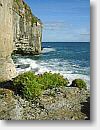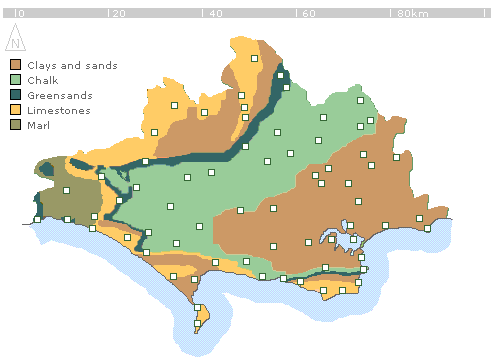
Search:


| Home | Gallery Index | about this site | contact us | links | copyright |

Search: |
Geological Map

to view a photo gallery - click on a marker
|
 |
Sketch MapThis sketch map shows the distribution of the main rock types that lie beneath the surface of the county. The nature of the Dorset landscape is heavily influenced by the underlying geology; in the east of the county where the rocks are soft the landscape is gentle and rolling, whereas in the west – where they are harder and hence more able to withstand erosion – the landscape takes on a more undulating form. The rocks beneath the surface also have an impact on the buildings erected above, particularly so in times past when local materials were often all that could be used. So a common material for construction in the east of the county was cob – mud mixed with straw (possibly bulked out with nodules of flint), whereas in the north-east green coloured sandstone prevails. In the north and west of the county the local soft golden-yellow limestones were used extensively, and finally in the south of the county are to be found the many fine buildings and mansions built from the hard pale-grey or cream limestones exposed along the coastal region – limestones that were valued throughout the rest of the country for their quality as a building material. Clays and sandsThe clay areas – which also include extensive areas of sand and gravel beds – are typified by gently rolling countryside (E.g. Arne and Middlebere), much of which is covered by heath (Holt Heath, Canford Heath). The clays in Dorset have been used extensively for brick making, good examples of their use in building construction can be seen in galleries for: Blandford Forum, Poole. ChalkWhilst chalk is a relatively soft material, eroding easily, some of the highest hills and most dramatic cliffs in Dorset are made of chalk (E.g. Ballard Down). Within the chalk are nodules of flint, a hard glass-like substance; in the chalk areas many buildings can be found that use a form of construction that consists of a repeated pattern of courses of brick interleaved with layers of flint nodules set in mortar (E.g. buildings in the Tarrant Valley). GreensandsThese are mostly soft sand and clay beds, typified by a greenish colour. To the north of the county they form harder beds, sufficiently so for the sandstone to be used for building; examples of which can be found in Shaftesbury. In the west of the county they form a hard layer protecting from erosion the softer marls beneath, such as can be seen at Golden Cap and in the area around Powerstock LimestonesThe hardest rocks in the county, extensively quarried along the coast (Portland and Purbeck being the main source) for use throughout the country. Ranging from pale grey in the south-east (E.g. Corfe Castle) to a cream yellow in the north-west of the county (E.g. Yetminster, Sherborne and Beaminster). MarlsLimy clays and shales that can form impressive – but unstable – cliffs, especially where capped by greensands (E.g. coast westwards from West Bay, at Golden Cap and Lyme Regis). Most famous for their fossil rich beds.
|